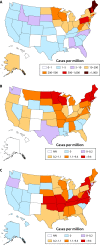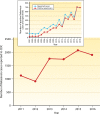Emerging Tick-Borne Diseases
- PMID: 31896541
- PMCID: PMC6941843
- DOI: 10.1128/CMR.00083-18
Emerging Tick-Borne Diseases
Abstract
Increases in tick-borne disease prevalence and transmission are important public health issues. Efforts to control these emerging diseases are frustrated by the struggle to control tick populations and to detect and treat infections caused by the pathogens that they transmit. This review covers tick-borne infectious diseases of nonrickettsial bacterial, parasitic, and viral origins. While tick surveillance and tracking inform our understanding of the importance of the spread and ecology of ticks and help identify areas of risk for disease transmission, the vectors are not the focus of this document. Here, we emphasize the most significant pathogens that infect humans as well as the epidemiology, clinical features, diagnosis, and treatment of diseases that they cause. Although detection via molecular or immunological methods has improved, tick-borne diseases continue to remain underdiagnosed, making the scope of the problem difficult to assess. Our current understanding of the incidence of tick-borne diseases is discussed in this review. An awareness of the diseases that can be transmitted by ticks in specific locations is key to detection and selection of appropriate treatment. As tick-transmitted pathogens are discovered and emerge in new geographic regions, our ability to detect, describe, and understand the growing public health threat must also grow to meet the challenge.
Keywords: Amblyomma; Anaplasma phagocytophilum; Babesia; Babesia microti; Borrelia; Borrelia burgdorferi; Borrelia mayonii; Borrelia miyamotoi; Crimean-Congo hemorrhagic fever virus (CCHFV); Ehrlichia chaffeensis; Ehrlichia ewingii; Ixodes; Lyme; Powassan virus (POWV); babesiosis; blood-borne parasites; deer tick virus (DTV); emerging disease; tick borne; tick-borne encephalitis virus (TBEV).
Copyright © 2020 American Society for Microbiology.
Figures





References
-
- Mansfield KL, Cook C, Ellis RJ, Bell-Sakyi L, Johnson N, Alberdi P, de la Fuente J, Fooks AR. 2017. Tick-borne pathogens induce differential expression of genes promoting cell survival and host resistance in Ixodes ricinus cells. Parasit Vectors 10:81. doi:10.1186/s13071-017-2011-1. - DOI - PMC - PubMed
-
- Ganguly S, Mukhopadhayay SK. 2008. Tick-borne ehrlichiosis infection in human beings. J Vector Borne Dis 45:273–280. - PubMed
Publication types
MeSH terms
LinkOut - more resources
Full Text Sources
Other Literature Sources
Medical
Research Materials

